[Continuation]
CHAPTER V―ASSOCIATION EXPERIMENTS
Galton, Wundt, Kraepelin, Aschaffenburg, Sommer and others, have introduced into psychology a very simple experiment, consisting of the calling out of a word to the test person, who must respond as quickly as possible with the first word that occurs to him. The reaction time between the stimulus word and the response, can be measured with a one-fifth second and stop watch. It was originally expected that this method would reveal certain intellectual differences in various individuals. But from the results of investigations carried out in the Psychiatric Clinic at Zürich, it has been found that it is not intellectual factors, but the emotions that play the chief part in determining these associations.
Two persons, of the same social plane, one intelligent, the other unintelligent, even with differences in the character of their intellectual development, may still produce similar associations, because language itself has many general word connections which are familiar to all sorts of individuals belonging to the same circle of society.
There are certain well-marked differences between the word associations of educated and uneducated persons. For instance, the uneducated prefer inner connections with deeper meaning, while the educated very often select simply superficial and linguistic associations. This difference depends, as has been ascertained, at the Zürich Clinic, upon the fact that the uneducated fix their attention more closely than the educated upon the actual meaning of the stimulus word. But attention, as has been shown by Bleuler, is nothing more than an emotional process. All affective processes are more or less clearly connected with physical manifestations, which are also to be observed in conjunction with attention. It is therefore to be expected that the attention roused by every association should have an influence upon the galvanometer curve, though this is but one of the affective factors represented in an association experiment.
We observe, as a rule, considerable variation in reaction time, even with practised and quick test persons. One is inclined to explain such irregularities, which are apparently accidental, by supposing the stimulus word to be unusual and difficult, or that the attention is momentarily relaxed or some reason or another. Such may at times be the case, but these reasons are not sufficient to explain the frequent repetition and long duration of certain reaction times. There must be some constant and regular rule to account for them. This disturbing factor has been found at the Zürich Clinic to be in most cases some characteristic thought complex of intrinsic importance for the personality of the test person. The following series will illustrate our meaning:―
|
Stimulus Word |
Reaction Word |
Reaction Time |
|
Head |
Hair |
1.4 |
|
Green |
Meadow |
1.6 |
|
Water |
Deep |
5 |
|
Stick |
Knife |
1.6 |
|
Long |
Table |
1.2 |
|
Ship |
Sink |
3.4 |
|
Ask |
Answer |
1.6 |
|
Wool |
Knit |
1.6 |
|
Spiteful |
Friendly |
1.4 |
|
Lake |
Water |
4 |
|
Sick |
Well |
1.8 |
|
Ink |
Black |
1.2 |
|
Swim |
Can Swim |
3.8 |
The four italicised numbers are abnormal1y long reaction times. The stimulus words are quite ordinary, not difficult, and are such as commonly carry numerous current connections. By questioning the patient, we learn that recently, when greatly depressed, he had determined to commit suicide by drowning. Water, lake, ship, swim, were words that excited this complex. The complex brought about lengthening of the reaction time. This phenomenon is quite usual, and is to be observed constantly and everywhere in association studies. Lengthened reaction time may therefore be regarded as a complex indicator, and be employed for the selection from a series of associations of such as have a personal significance to the individual. It is self-evident that associations of this kind are apt to be accompanied by lively emotional tone. The explanation would be simple if the test person were always conscious of the complex which had been excited. But it is extraordinarily common for the test person to be unconscious of the complex disturbed by the stimulus word, and to be unable to answer questions relating to it. It is then necessary to employ the psycho-analytic method, which Freud uses, for the investigation of dreams and hysteria. It would carry us too far to describe here the details of this method of analysis, and readers must be referred to Freud's works [4].
The cause of the interference with the reaction must be sought for in the strong emotional tone of the complex.
Individuals with good powers of introspection often affirm that they could not respond quickly, because of the sudden crowding into consciousness of a number of words among which they could find none suitable for the reaction. This is easily understood, for strong affects always collect numerous associations around them, and, on the other hand, an assemblage of associations is always accompanied by an intense emotional tone. In some cases we have an opposite condition from the above, and the test persons are not able to react because of a vacuum in consciousness, in which event the complex hinders reaction by simply not appearing in consciousness. Thus the underlying thought complex sometimes carries too much into consciousness, and at other times too little, in either case disturbing the uniform flow of psychic functions. It acts like a peace-breaker in the psychic hierarchy. Such being the behaviour of the complex under normal conditions, it is easy to understand how it may play the chief part in abnormal mental states based upon disordered affectivity.Lengthened reaction time is not the only index of a complex. If the stimulus word causes a sudden embarrassment and brings out some striking and unusual reaction-word, it is certain that a complex has been struck, so that any reaction out of the ordinary may also be regarded as indicating the presence of an emotional thought complex.
It is thus that affective factors present themselves everywhere in our associations; and it is of interest to ascertain whether the psycho-galvanic reflex runs a parallel course with the complex indices just described; whether it does so regularly or has a preference for certain constellations; whether differences exist when a complex is conscious or unconscious, &c.
Wherever possible, we have employed the pneumograph at the same time with the galvanometer in these association studies to determine whether parallel disturbances were present.
The association question is many-sided, and there are numerous methods by which to study it. We shall try in the following pages to present our method and to confine ourselves more especially to our method of investigation, rather than to bring forward too prominently results which, owing to the small number of individuals examined, have simply a casuistic value, and cannot be looked upon as having general application.
I.―The Results Obtained with Association Tests
When the experiment is ended we measure the heights of the galvanometric curves and arrange them in a table, with results of the tests, as follows:―
Case I―Uneducated man, aged 40, normal, two series of word associations, each twenty-four words. (Nine words given as example.)
Series I
Series II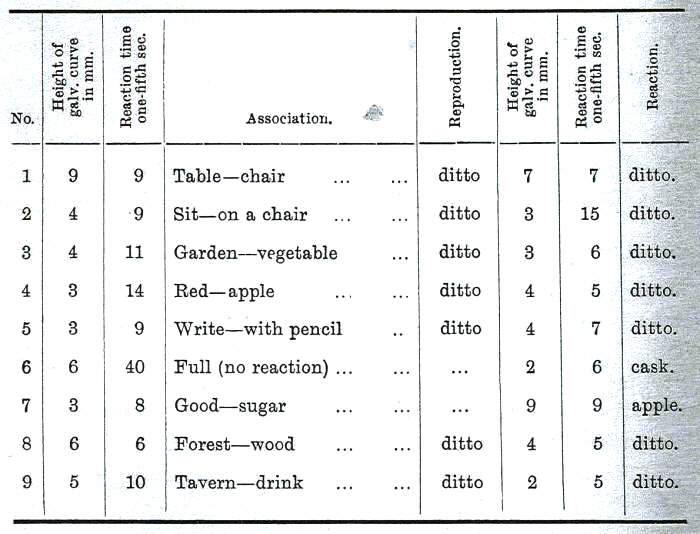
As shown in the table, we made one repetition of the experiment in this instance; in other cases two repetitions were made.
(2) We then determine the arithmetical average of the galvanometric deviations, which in this instance is 4.9 mm. These figures are naturally only relative and, with our apparatus, correspond to only one-half of the actual movement of the mirror of the galvanometer. (The actual figure would be 9.8 mm.)
(3) We then determine the probable average (Kraepelin) of the reaction times in the following manner: The figures are arranged in a column in the order of their size, and the middle number is taken, which in this instance is 1.8 seconds. The probable is here preferred to the arithmetical average, because occasionally very high numbers occur in such tests, where the reaction times are so much more liable to increase than diminution. An arithmetical average would be unduly influenced by the occasional presence of one or more large numbers, and would not give us the actual average of the reaction time.
(4) In the second series the average of the galvanometer deviations was 4.8 mm., and that of the reaction times 1.2 seconds. We observe, therefore, a reduction in the average height of the galvanometer curve, which is clearly due to lessening of the power of the stimulus in the repetition. The same phenomenon is also seen in the average of reaction times, which is shortened. The fact that every reaction is accompanied by a galvanometer movement is due to the emotion of attention which accompanies each reaction and is great enough to produce notable physical changes.
(5) We note that in the second series certain associations (the sixth and seventh) are repeated with a change of words. These defective or changed reproductions indicate that the psychological constellation for the respective associations had changed in the short time (a little over one half hour) that had elapsed since the first series had been given. We know that associations which belong to certain complexes are those that may, because of inner conditions, suffer change within a short period of time. We may therefore, expect that such false reproductions carry with them particular emotional phenomena; and this is actually here the case. The arithmetical average of the altered reproductions is 5.7 mm., while in the first series the average for the same associations was 4.5 mm. Furthermore, the altered reproductions in the second series show an excess of some 0.8 mm. over the average of the stimulation of the first series. The average of the reaction times for the altered reproductions is l.2 seconds, and for the correct reproduction 1 second, as would be expected. We learn from this that the supposition that the altered reproductions are affective phenomena would seem justified. We will not here enter into details in relation to the psycho-analysis of such manifestations, as we do not wish to forestall an especially careful study of this question now being made in this clinic by Dr. Binswanger.
(6) From the above consideration one would also expect that those associations which are changed in the repetition should also present some sort of affective signs in the first series; but, contrary to our expectation, we see in this case that the average height of the galvanometer deviation for the words subsequently changed in repetition is 4.8 mm., while the average for the unaltered reproductions is 5 mm. This difference is, of course, small, and no particular deduction could be drawn from one case. It is to be noted that the reaction time (average) for the associations subsequently wrongly reproduced is 1.9 seconds, and for the words correctly reproduced 1.8 seconds. Perhaps there is here a slight indication of the phenomenon to which we refer.
(7) In the preceding paragraphs we have frequently intimated that there is a certain connection between affectivity and the length of reaction time, and this has been already carefully determined in the work of one done by one of us (Jung [6]). One may expect to have, as a rule, large galvanometer curves with long reaction times, always, however, with the limitation that such lengthened reaction times only are considered which are connected with associations that directly excite complexes, and not the long reaction times which may follow immediately after reactions which excite complexes. These latter are frequent as examples of perseveration. In order to discover the actual complex-exciting association it is necessary to employ the analytic method, and for this purpose a more suitable material is needed than is at our disposition. We, therefore, content ourselves here with simply determining the average height of all galvanometer curves in relation to times which lie respectively above and below the average.
In Series I the average galvanometer curves connected with long reaction times is 4.5 mm.; and with short reaction times 6.1 mm.
In Series II the galvanometer curves, with long reaction times average 5.7 mm.; and with short reaction times 4.4 mm.
The two results are contradictory. The cause of this lies in factors already alluded to and in other difficulties which must be the subject of later study.
(8) The alteration of the psychological constellation of Series II already mentioned may be manifested in the galvanometer curve alone, without any change in the reproductions. This matter might be thus explained. In the first trial only certain meanings are attached to them stimulus word by the test person, i.e., not all of the associations belonging to it are excited at the first trial, while at the second trial another series of new connections may be aroused. We very often meet this phenomenon in our psycho-analytic investigations.
It is of the greatest importance for the individual and his intellectual processes to know how his associations are presented to consciousness, whether he has quick and complete command of all related associations. This point is of the utmost value for tests of the intelligence, since many persons may appear to be stupid during investigation because their associations are not at immediate command, and on the other hand stupid persons may seem to be relatively intelligent simply because they have good command of their associations. We may perhaps also expect by this means to discover important differences between educated and uneducated intellects, and the galvanometric experiments seem to open to us endless vistas.
In this case 41.6 percent of the associations in Series II show an increased galvanometric curve with an average plus difference of 2.3 mm. It is possible that later investigations may show us that this result has considerable psychological significance for the individual, because this test person was quite unintelligent.
(9) We observe frequently after a marked galvanometric deviation, that there is an inclination to successive large curves, if the succeeding stimuli are not too quickly given. This is not unexpected because it is a general psychological experience that strong affects induce great sensitiveness (see Jung [6]). If therefore we take the average of the curves which follow unusually strong galvanometer curves and compare them with the arithmetical average of all the curves, we find that after high curves, the average height in Series I is 5 mm. and the reaction time two seconds in contrast with the general averages of 4.9 mm. and 1.8 seconds. In Series II these figures are reversed, for here the average has a plus difference of 0.6 mm. while the average of the reaction times shows a minus difference of 0.5 seconds. The relations are not quite definite.
(10) The whole of Series I shows a rather uniform course, for the average of distribution amounts only to 1.6. The deviations are relatively not very high. The highest curve is 12 mm., and the association connected with it is
Stupid―am I
which was for this individual a clear ego-centric stimulus which evidently struck a strong emotional complex.
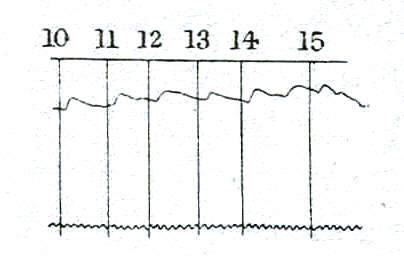
Fig. 12. Portion of curve in
word-associations of a normal test-person.
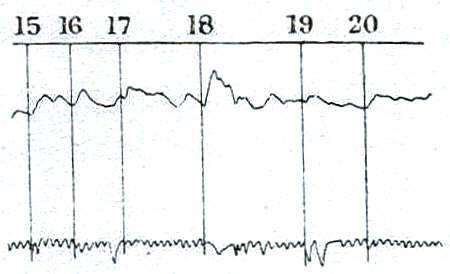
Fig. 13. Portion of curve
corresponding to the word-association "Stupid―am I.”
Fig. 12 is a portion of the curve in this case. In this, one notes the even course and uniform emotion of each association. The accompanying pneumographic curve is undisturbed.
Fig. 13 shows the portion of the curve in which the association stupid-am I (reaction No. 18) occurred. This portion is marked by a very high many-pointed wave. The pneumographic curve is altered here, as it is also in reaction No. 19, though the latter has little emotional tone. But No. 19 has, however, a very long reaction time (4.8 secs.), which is to be looked upon as a persisting intellectual disturbance from reaction No. 18. We observe here one of the numerous instances where the pneumographic curve and the reaction time show evident disturbances, while the galvanic curve is unaffected. According to our hypothesis, this is owing to the fact that the galvanometer indicates only acute affective conditions, and not the more lasting intellectual after-effects, these latter being often well registered by reaction time and pneumograph. The reaction time shows how long the mind requires to detach itself from its conscious or unconscious pre-occupation, and turn to the new stimulus. The respiration, because of its close relation to consciousness (susceptibility to voluntary influences), is also affected by intellectual processes, while the galvanometer seems to be influenced directly only by the unconscious.
Case 2.―Uneducated but rather intelligent man, aged 38.
(1) We have arranged in the following table the results of three series of associations of twenty-four words each:―
| Series I | Arithmetical average of galvanometer curves | 5.6 mm. |
| Series II | Arithmetical average of galvanometer curves | 7.2 mm. |
| Series III | Arithmetical average of galvanometer curves | 5.9 mm. |
| Series I | Probable average of reaction times | 1.8 sec. |
| Series II | Probable average of reaction times | 1.3 sec. |
| Series III | Probable average of reaction times | 1.0 sec. |
The reaction times are what we expect, but the galvanic curves show an unexpected increase in the second series. Our first supposition would be that this is owing to some physical change; for instance, better contact from increased warmth of the hands, or a change of posture of the body that increased the pressure of the hands upon the electrodes. Such conditions may not only interfere with the experiment, but also render comparison of results difficult. But it is also possible that the psychological constellation changed in the second series, causing thereby greater elevation of the galvanometer. If we take the first fifteen curves of Series II, we find the average to be 4.7 mm., which is much less than the average of Series I. But if we take the last nine curves of Series II, we find the average to be 11.3 mm., and that the cause of great difference lies where the principle of loss of power in repeated simulation does not seem to be effective. It is possible that after the fifteenth reaction there was a physical disturbance which increased the height of the curves.
We find that the probable average of the reaction times of the first fifteen and last nine reactions both amount to 1.8 seconds, while the average of the galvanometer curves of the first fifteen reactions show only a minus difference of 0.2 mm., as compared with the last nine curves. Now, if a physical change occurred toward the end of Series II, we might expect no change in the purely psychological reaction times. This is, however, not the case. For the increased galvanic curves in the last nine reactions correspond to an increase of the reaction times (1.4 seconds, as compared to 1 second of the first fifteen reactions), There is, therefore, a parallel between the galvanometer increase and the increased reaction times, from which we may conclude that the increase depends upon an altered psychological constellation.
We have already mentioned that a change in the constellation is owing to the arousing of complexes. The reactions as occur in this wise:―
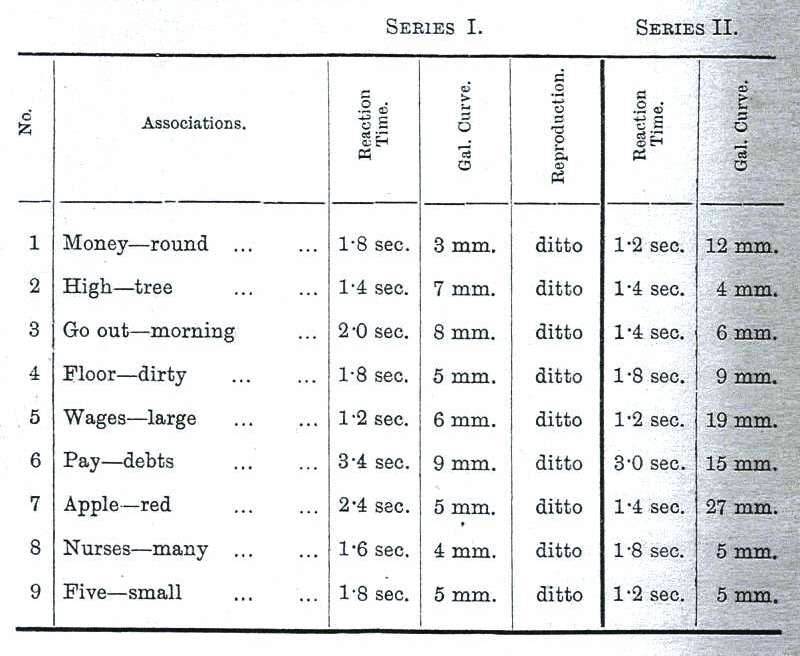
While as a rule the reaction times are shortened in Series 11, the galvanometer curves are higher. It seems as if the affects first really manifested themselves in Series II after having been inhibited in Series I. As is shown, the largest increases are connected with the associations, "money―round, floor―dirty, wages―large" (the test person is an attendant or nurse and receives small wages), "pay―debts, apple―red, and nurses―many." It is easy to understand that five of these associations might arouse strong sentiments. The strong reaction with "apple red" is incomprehensible But we have frequently noticed that quite indifferent associations following immediately upon strong emotional associations show in repetition sudden increase of galvanic reaction, as if the emotional tone were postponed. It is not impossible that we have such a phenomenon here, but we have no means of proving it. Affects are always inhibited if some other strong emotional complex displaces them. This was evidently the case here, because the unusual experiment excited the test person, so that he probably did not grasp the stimulus words in all their personal relations. In Series II he was more quiet and could comprehend better, in consequence of which emotional tones were more easi1y developed than before. This phenomenon is theoretically very important, since it indicates how affects are repressed in normal persons. Inhibition of affects plays a powerful rôle in psycho-pathology. (See the works of Freud, Bleuler and Jung.)
This experiment also illustrates well that reaction time and galvanometer curve do not mean the same thing. We see here again how clearly the reaction time reveals a greater intellectual freedom than in Series II, whereas the galvanometer curves are considerably higher than those of Series I.
| Galv. Curve | Reaction | |
| (2) The altered reproductions of Series II average |
6 mm. |
1.7 sec. |
| The altered reproductions of Series III average | 7 mm. | 1.0 sec. |
| The unchanged reproductions of Series II average | 7.3 mm. | 1.3 sec. |
| The unchanged reproductions of Series III average | 5.8 mm. | 1.3 sec. |
Here, too, the relations are somewhat obscure, which may be owing to the occurrence of very few altered reproductions. Only half of the above numbers coincide with our expectations.
| (3) Galvanometer curves with long reaction times average in Series I | 6.4 mm. |
| Galvanometer curves with short reaction times average in Series I | 6.4 mm. |
| Galvanometer curves with long reaction times average in Series II | 8.1 mm. |
| Galvanometer curves with short reaction times average in Series I | 4.2 mm. |
| Galvanometer curves with long reaction times average in Series III | 6.8 mm. |
| Galvanometer curves with short reaction times average in Series I | 4.1 mm. |
The first test is undecided, but the two following present figures which correspond with our expectation. (In Case 1 above recorded the first test also gave a contradictory result.)
(4) In Series II 41.6 per cent of the association show an average plus difference of 3.2 mm, compared with Series I.
In Series III 45.8 per cent of the associations show a plus difference of 2.6 mm. as compared with Series II.
These figures prove, as already mentioned, that Series II presents a considerably altered constellation. In Series III there are still more psychological constellations changed. It is to be regretted that there was not a much larger material at hand for the farther investigation of matters so important for the psychology of the individual.
| (5) Series I. Probable average of reaction times in associations with unusually high galvanometer curves | 2.2 sec. |
| Series I. Arithmetical average of the corresponding galvanometer curves | 5.2 mm. |
| Series II. Probable average of reaction times in associations with unusually high galvanometer curves | 1.6 sec. |
| Series II. Arithmetical average of the corresponding galvanometer curves | 12.0 mm. |
| Series III. Probable average of reaction times in associations with unusually high galvanometer curves | 0.8 sec. |
| Series III. Arithmetical average of the corresponding galvanometer curves | 7.0 mm. |
The curves in Series II and III do not, while those of Series I do correspond to expectation. The reaction times in Series I and II are what we anticipate. Therefore, of six items, four coincide with our expectation.

Fig. 14. Portion of pneumographic curve
in Case 2 (word-association, normal individual).6
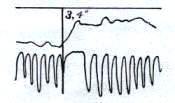
Fig. 15. Galvanic and pneumographic
curve corresponding to the word-association "pay―debts."
(6) Series I presents in general a uniform character. The average of distribution is only 1.5 mm. The highest curve measures 9 mm., and this is connected with the association “pay―debts," which, as we have seen, also preserves its high emotional value in Series II.
Series II is much more irregular. The average distribution is 3.8 mm., at very high figure, which well illustrates the irregularity of the series. The highest curves of this series have already been described.
Series III presents, on the other hand, another with uniform character. The average of distribution is only 1.8 mm. The highest curve occurs with the association "wages―large," and amounts to 11 mm., and in Series II it also had a high value. Such concord shows clearly that these figures are not accidental.
The pneumographic curve presents no peculiarities. In Series I, with indifferent associations, this curve has the aspect shown in fig. 14.
Fig. 15 is the galvanometric and pneumographic curve belonging to the association "pay-debts." In this we observe a marked inhibition of respiration during and after the critical association.
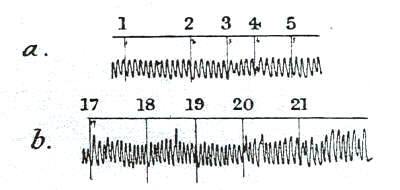
Fig.
16 (a and b).
(a) Respiratory curve, with
word-associations No.1 to 5
(b) Curve, same case, associations No. 17 to 21.
The psychic excitation referred to previously in the last nine associations of Series II seems to manifest itself in the pneumographic curve, as apparently evidenced in figs. 16a and 16b.
Fig, 16a is a portion of the respiratory curve during associations 1 to 5. Fig. 16b represents associations 17 to 21. The difference is marked. We can hardly be mistaken in supposing that the change in respiration is the expression of a certain excitation, which is in harmony with our previous assumptions.
Case 3. Uneducated man of moderate intelligence, aged 28, lively, excitable temperament. Normal. Three series of associations, each with twenty-three words.
| (1) Series I. Arithmetical average of galvanometer curves | 14.2 mm. |
| Series II. Arithmetical average of galvanometer curves | 6.5 mm. |
| Series III. Arithmetical average of galvanometer curves | 2.0 mm. |
| Series I. Probable average of reaction times | 2.4 sec. |
| Series II. Probable average of reaction times | 2.2 sec. |
| Series III. Probable average of reaction times | 2.0 sec. |
The curves of Series I reach a considerable height, but the stimulus diminishes rapidly and intensely in power in the succeeding series.
The reaction times shorten uniformly, but are still in general somewhat long, as we observe not infrequently among emotional people.
| Galv. |
Reaction |
|
| (2) The altered reproductions of Series II, average | 7.9 mm. | 2.0 sec. |
| The unchanged reproductions of Series II, average | 1.8 mm. | 2.2 sec. |
| The altered reproductions of Series III, average | 3.5 mm. | 2.2 sec. |
| The unchanged reproductions of Series III, average | 1.3 mm. | 2.1 sec. |
The galvanic curves correspond in both series to our expectation, but the reaction times in Series II are contradictory, which, however, is changed if we do not employ the probable average (as is ordinarily done by us in all cases) but the arithmetical average, when the average time for altered reproduction is 2.8 sec., and for the unchanged only 2.4 sec.
| (3) The galvanic curves with long reaction time in Series I average | 17.8 mm. |
| The galvanic curves with short reaction time in Series I average | 12.7 mm. |
| The galvanic curves with long reaction time in Series II average | 9.8 mm. |
| The galvanic curves with short reaction time in Series II average | 3.6 mm. |
| The galvanic curves with long reaction time in Series III average | 2.1 mm. |
| The galvanic curves with short reaction time in Series III average | 0.0 mm. |
All these figures are in perfect accord with our hypothesis.
(4) In Series II 17.3 per cent of the associations have an average plus difference of 5.8 mm.
In Series III. 17.3 per cent. of the associations have an average plus difference of 2.8 mm.
These figures show that the constellation in the latter series is not very much changed, with the exception of a few associations. We may conclude that all the strong emotional relations of the stimulus words were brought out in the first test. We should say here that Case No. 3 was well accustomed to this kind of experiment, while No.1 and No.2 were not.
| (5) Series I. Probable average of reaction times in associations with unusually high galvanometer curves | 2.8 sec. |
| Series I. Arithmetical average of the corresponding galvanometer curves | 22.3 mm. |
| Series II. Probable average of reaction times in associations with unusually high galvanometer curves | 1.8 sec. |
| Series II. Arithmetical average of the corresponding galvanometer curves | 11.4 mm. |
| Series III. Probable average of reaction times in associations with unusually high galvanometer curves | 1.2 sec. |
| Series III. Arithmetical average of the corresponding galvanometer curves | 1.7 mm. |
The galvanic curves are what we would expect in Series I and II, but not ion Series III. The reaction time is what we expect in Series I.
| Galv. |
Reaction Time |
|
| (6) Series I. Average of associations altered in subsequent reproduction | 14.4 mm. |
2.4 sec. |
| Series I. Average of associations unchanged subsequently | 13.5 mm. |
2.0 sec. |
| Series II. Average of associations altered in subsequent reproduction | 8.7 mm. |
2.2 sec. |
| Series II. Average of associations unchanged subsequently | 3.6 mm. |
2.0 sec. |
All of these figures coincide with what we expect.
(7) The general course of Series I. is very irregular. The average of distribution is 7.6, the highest number we have yet observed. In the tests with Cases 1 and 2 the various phases of stimulation were shown in strong, but much differentiated, emotions, but in this case with lively temperament there was a continual and marked fluctuation of emotions, and hence the high average of distribution.
Series II is more uniform, and the average of distribution is 5.4, and in Series III this average is only 2.3.
The highest galvanic curve in Series I measures 51.5 mm. and is connected with the association “the sun―burns." Why there should be here so strong a reflex innervation could not be understood without further examination. The test person himself could not explain why he had any particular emotion at this moment. But the connection was shown in the following associations. The other high curves (37, 21, and 18 mm.) occurred with the associations “floor―parquet,” "pay―write," “warm―the stove." These three associations showed constant and similar disturbances in all three series, as illustrated in this table:―
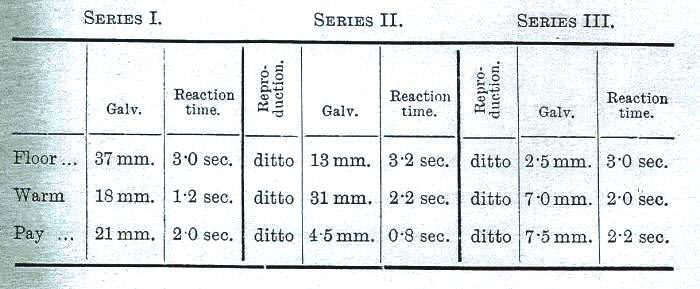
All the reproductions were altered. With one exception all of the galvanometer curves were considerably above the averages for each of the series. As to the nine reaction times, four were above, and two coincided with the probable averages. It seemed justified from these observations to assume that a strong emotional complex lay behind them. But when questioned the test person answered that he had had no particular thoughts in connection with these reactions, and was evidently unconscious of any special complex. Yet even if a test person asserts that no complex is present, this is not conclusive in the face of so many indications pointing to interference by a complex. In this instance we distracted his attention from the matter in hand and asked what personal significance the word "floor” had for him, when suddenly he said with surprise and embarrassment that recently a stove in his dwelling had become defective and burned the floor to such an extent that he had not only to pay for a new stove, but also for an entire new floor which was a hardship for him. Besides this there had been great danger from fire. Thus were all the disturbances above related perfectly explained, including the strong emotional tone of the association "the sun―burns."
We learn from this interesting episode that the galvanic phenomenon, like reaction time and alteration of reproductions, may give evidence of the existence of an unconscious complex. We cannot go into farther detail regarding this fact here, but the investigations of Dr. Binswanger already mentioned also throw much light on this subject.
The above described: group of associations gives an unusually fine picture in Series II of emotional effect upon the curves (fig. 17). At the beginning we have indifferent reactions. Reaction No. 18 IS “floor," 19 "warm," 20 “wages―small," and 21 "pay."
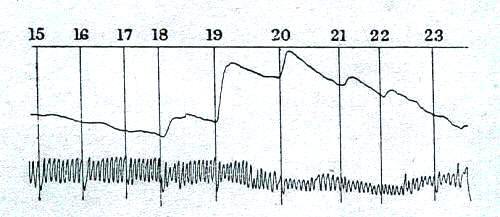
FIG. 17.
Portion of a curve to show emotional effect of certain word-associations.
The respiratory curve also shows the reactions very clearly. In general, inspiration is increased which is especia1ly characteristic for this particular case in connection with expectant attention. The condition during the unconscious complex excitation seems therefore to have had a certain resemblance to the tension of expectation. An example of this tension of expectation in this case at the beginning of a test is shown in fig. 18.

Fig. 18.
Expectation curve in Case 3.7
| (A) Series I. Arithmetical average of galvanometer curves | 6.8 mm. |
| Series II. Arithmetical average of galvanometer curves | 1.9 mm. |
| Series III. Arithmetical average of galvanometer curves | 0.9 mm. |
| Series I. Probable average of reaction times | 1.2 sec. |
| Series II. Probable average of reaction times | 1.0 sec. |
| Series III. Probable average of reaction times | 1.0 sec. |
The galvanic curves show very rapid diminution, while the reaction time is very short and the lowest limit is soon reached.
| Galv. |
Reaction |
|
| (B) The altered reproductions of Series II, average | 7.5 mm. | 1.6 sec. |
| The unchanged reproductions of Series II, average | 1.6 mm. | 1.0 sec. |
| The altered reproductions of Series III, average | 0.0 mm. | 1.0 sec. |
| The unchanged reproductions of Series III, average | 1.0 mm. | 1.0 sec. |
The result in Series II is what we expected, but this is not true of Series III, perhaps because only very altered reproductions occur.
| (C) The galvanic curves with long reaction time in Series I average | 11.6 mm. |
| The galvanic curves with short reaction time in Series I average | 5.2 mm. |
| The galvanic curves with long reaction time in Series II average | 5.4 mm. |
| The galvanic curves with short reaction time in Series II average | 0.8 mm. |
| The galvanic curves with long reaction time in Series III average | 1.0 mm. |
| The galvanic curves with short reaction time in Series III average | 1.5 mm. |
The figures in Series I and II are what we expected, but not in Series III, perhaps because most of the curves had already sunk to zero.
| (D) In Series II 5.5 per cent of the associations show and average plus difference of | 6.0 mm. |
| In Series III 11.1 per cent of the associations show and average plus difference of | 2.7 mm. |
In this case also we note a great readiness of the association to appear fully on the first stimulus, so that the constellation does not change much later on.
| (E) Series I. Probable average of reaction times following associations with unusually high galvanometer curves | 1.1 sec. |
| Series I. Arithmetical average of corresponding galvanometer curves | 6.5 mm. |
| Series II. Probable average of reaction times following associations with unusually high galvanometer curves | 1.0 sec. |
| Series II. Arithmetical average of corresponding galvanometer curves | 1.2 mm. |
The figures in Series III are omitted because most of the galvanic curves were reduced to zero. The figures given in the above series do not accord with our expectation.
| Galv. |
Reaction Time |
|
| (F) Series I. Average of associations altered in subsequent reproductions | 4.3 mm. |
4.0 sec. |
| Series I. Average of associations unchanged subsequently | 4.4 mm. |
1.2 sec. |
| Series II. Average of associations altered in subsequent reproductions | 6 mm. |
1.2 sec. |
| Series II. Average of associations unchanged subsequently | 1.6 mm. |
1.0 sec. |
These figures are what we would expect.
| (G) Average of distribution in Series I | 5.5 |
| Average of distribution in Series II | 2.2 |
| Average of distribution in Series III | 1.6 |
We find as usual the greatest variation in the figures in the first series. With lessening power of the stimulus in the repetitions a levelling tendency is manifested as regards this variation in the power of the stimulus.
The highest curves are found in the following associations:―
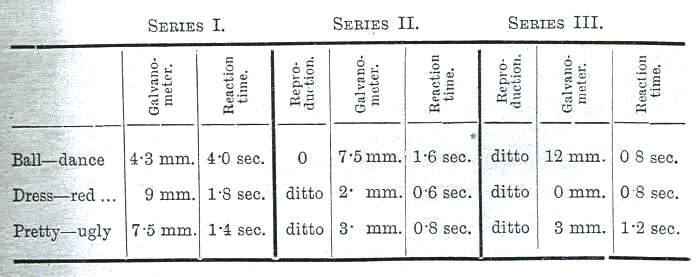
The galvanic curves are much higher than the average in all three series for the association " ball-dance." The intensity of the affect here is shown by the fact that while fifteen out of the eighteen reactions in the last series caused no deviations of the galvanometer, this particular association induced a deflection of 12 mm. In this instance the test person expected in a few days to go to a fancy dress ball, but despite much search had not yet found a suit costume. She was, therefore, in a state of anxiety concerning it. The association "dress" and "pretty" are self-evident.
The reaction times were rapidly shortened in the repetitions, because of her natural aptitude in speech. It is evident that at times the galvanic phenomenon is more helpful than lengthened reaction times in demonstrating emotional states.

FIG. 19. Word
association "ball-dance" in Case 4.
Fig. 19 is a curve from Series III in this case representing the well-marked association "ball―dance." Repetition of the association test is to be recommended when one desires to bring out more clearly very strong emotional complexes.
§2.―Résumé of the Tests with Word Associations in Normal Individuals.
Our limited material, consisting of the word associations in one educated woman and three uneducated men leads us to bring forward with much reserve a résumé of our results. We know that they must be regarded as only preliminary, and as being of questionable value, but at the same time they foreshadow features of interest for future enquiry and investigation. Our intention in this work is chiefly to point out indications, and our presentation of results must be taken in this sense.
(l) The average, plus difference of a galvanic curve, produced by an association whose reaction time exceeds that of the probable average of the same series, is 2.7 mm.
Taking into consideration the above-mentioned limitations this figure seems to express that in certain cases there is a clear parallelism between the length of reaction time and the height of the galvanometer curve. This method appears, therefore, to afford a psycho-physical proof of the hypothesis of one of us (Jung [6]), that very long reaction times are affective phenomena.
(2) Altered reproductions show an average plus difference of 2 mm. over unchanged reproductions.
(3) Such associations as are changed in the reproductions of the following series present an average plus difference 6.8 mm. over such as are reproduced subsequently unchanged.
These two figures, especially the last, seem to offer a psycho-physical confirmation of the hypothesis of one of us (Jung [6]), that altered reproductions are affective phenomena.
The remaining methods embodied in the text of our work have little right to a special summing up here, because of the scantiness of our material, and also because of some contradictions in our results.
§3―Word Associations in Dementia Præcox
There were but two of our cases of paranoid dementia that could be used for a test of word associations with the galvanometer.
Case 1―Male, aged 36, very intelligent, academic education. Speech well preserved. Two series of associations, with twenty-four words each.
| (A) Series I. Arithmetical average of heights of galvanometer curves | 11.6 mm. |
| Series II. Arithmetical average of heights of galvanometer curves | 4.6 mm. |
| Series I. Probable average of reaction times | 6.6 sec. |
| Series II. Probable average of reaction times | 4.8 sec. |
The average height of the galvanometer curves falls in both series within normal limits, which is not the case with the reaction times, which show excess. 0ur four normal test persons presented the following average:―
| Series I | Galvanometer curves 7.8 mm. | Reactions times 1.8 sec. |
| Series II | Galvanometer curves 5.1 mm. | Reactions times 1.4 sec. |
From these figures it is seen that the patient offers a strong contrast in the length of the reaction times.
| (B) The altered reproductions in Series II average | 4,7 mm. | 6.0 sec. |
| The unchanged reproductions in Series II average | 3.4 mm. | 2.8 sec. |
These figures coincide with the normal, and are what we would expect. But we note that the unchanged reproductions present a much lower value in the reaction time that the altered reproductions.
| (C) The galvanometer curves with long reaction times in Series I average | 13.1 mm. |
| The galvanometer curves with short reaction times in Series I average | 10.3 mm. |
| The galvanometer curves with long reaction time in Series II average | 3.8 mm. |
| The galvanometer curves with short reaction time in Series II average | 4.0 mm. |
In this table the figures in Series I, but not Series II, are what we expect.
(D) In Series II 12.5 of the associations show an average plus difference of 4.4 mm.
| (E) Series I. Probable average of reaction times following associations with unusually high galvanic curves | 4.0 sec. |
| Series I. Arithmetical average of the corresponding galvanic curves | 10.0 mm. |
| Series II. Probable average of reaction times following associations with unusually high galvanic curves | 7.6 sec. |
| Series II. Arithmetical average of the corresponding galvanic curves | 3.2 mm. |
In this table, only the reaction time of Series II is in accordance with our expectation.
| Galv. |
Reaction Time |
|
| (F) Series I. The associations with altered reproductions in the following series, average | 9.8 mm. |
6.6 sec. |
| Series I. The associations with unchanged reproductions in the following series, average | 13.5 mm. |
5.4 sec. |
Only the reaction time here is what we would expect.
(G) The average of distribution in Series I. was 5.8. The average of distribution in Series II. was 3.4.
These figures are similar to those of Case 4 among the normal.
The highest galvanic curve occurred with the reaction “love―a psychic process" (30 mm.), and here was also the longest reaction time (27.2 sec.) The next highest curve was connected with the reaction "wife―marriage-Iaw" (29 mm.) The patient is single, and having had with "love" a strong emotional tone, it was not surprising that "wife" should also evince a similar intensity. Another high curve was found in the association "sick-at-heart " (26 mm.) The patient still some insight into his condition, and knew that he was confined in the asylum because of his mental malady, hence strong emotion connected therewith. The word "handsome" produced a curve of 25 mm. The patient is very vain, and pays extraordinary attention to his dress. The contents of the association present the symptoms of affectation, which is evident from his external appearance. Most of his associations showed a definition character which, in educated people, always indicates a certain amount of affectation. The following are examples:―
Write―Activity
Shoes―Footwear Hat―An article of clothing House―Building construction To sit―Condition of rest Money―Medium of exchange Proud―Adjective
The long reaction times may be due to this affected manner of expression, though this can hardly be the only cause.
Case 2.―Woman, single, aged 62, uneducated, medium intelligence. Speech mingled with neologisms. Three series of associations with twenty-five words each.
| (A) Series I. Arithmetical average of the galvanic curves | 7.9 mm. |
| Series II. Arithmetical average of the galvanic curves | 3.6 mm. |
| Series III. Arithmetical average of the galvanic curves | 2.5 mm. |
| Series I. Probable average of reaction times | 10.8 sec. |
| Series II. Probable average of reaction times | 6.4 sec. |
| Series III. Probable average of reaction times | 6.0 sec. |
As in the former case, the galvanic deviations of medium height, while the reaction times are extraordinarily long.
| Galv. |
Reaction |
|
| (B) The altered reproductions in Series II, average | 3.6 mm. | 6.6 sec. |
| The unchanged reproductions in Series II, average | 3.6 mm. | 5.2 sec. |
| The altered reproductions in Series III, average | 2.5 mm. | 7.4 sec. |
| The unchanged reproductions in Series III, average | 2.4 mm. | 4.6 sec. |
The reaction times accord with our expectation, as in the former case, much better than the galvanometer curves.
| (C) The galvanometer curves with long reaction times in Series I, average | 9.6 mm. |
| The galvanometer curves with short reaction times in Series I, average | 6.0 mm. |
| The galvanometer curves with long reaction times in Series II, average | 4.7 mm. |
| The galvanometer curves with short reaction times in Series II, average | 2.6 mm. |
| The galvanometer curves with long reaction time in Series III, average | 2.8 mm. |
| The galvanometer curves with short reaction time in Series III, average | 2.5 mm. |
The figures in all three series are what we expect.
(D) In Series II 28.0 per cent of the associations show an average plus difference of 4.7 mm. In Series III 24.0 per cent of the associations show an average plus difference of 4.8 mm.
| (E) Series I. Probable average of reaction times following associations with unusually high galvanic curves | 11.6 sec. |
| Series I. Arithmetical average of corresponding galvanic curves | 11.8 mm. |
| Series II. Probable average of reaction times following associations with unusually high galvanic curves | 5.8 sec. |
| Series II. Arithmetical average of corresponding galvanic curves | 3.7 mm. |
| Series III. Probable average of reaction times following associations with unusually high galvanic curves | 8.0 sec. |
| Series III. Arithmetical average of corresponding galvanic curves | 2.5 mm. |
Twice the reaction times are what we expected, the galvanic curve sonly once, and in Series III the arithmetical average is the same.
| Galv. |
Reaction Time |
|
| (F) Series I. The associations with altered reproductions in the following series, average | 9.0 mm. |
10.4 sec. |
| Series I. The associations with unchanged reproductions in the following series, average | 6.3 mm. |
12.4 sec. |
| Series II. The associations with altered reproductions in the following series, average | 3.3 mm. | 6.6 sec. |
| Series II. The associations with unchanged reproductions in the following series, average | 4.0 mm. | 4.8 sec. |
We find in this table that only the galvanic curves in Series I and the reaction times in Series II are what we expected.
(G) The average of distribution in Series I was 4.9
The average of distribution in Series II was 2.8.
The average of distribution in Series III was 1.6.
The highest galvanic curve is found in the association “sun―sun-time," and here the reaction is14.0 seconds. It is difficult to explain this excessive deviation. The preceding association is "stout-constitution” (15mm., and 14.8 seconds reaction time). The patient is very stout, which she thinks due to supernatural influences. She complains much of this "forced" disfigurement. In Series II these two associations caused no deviations, but in Series III "stout―constitution" suddenly induced the largest deflection of the whole series, viz., 14.5 mm., whereas the average was only 2.5 mm. There was a curve of 20 mm. with the association “ugly―disfigured by great suffering,” and with this a reaction time 12.0 seconds. The contents of this association are concerned with the same theme as "stout-constitution." Another high curve occurred with "high―highest action" (19 mm. and reaction time 11.2 seconds). This association was subsequently altered twice in the reproductions. It is connected with the delusion of the patient that she had accomplished the "highest work.”
The associations are typically affected and show a distinctly morbid character.
The following are examples:―
Diligent―High esteem―Payment
Love―To be lovable―Wedding
Snake―To point out as extraordinary
High―Highest action―Highest distinction
Ugly―Disfigured by great suffering
Résumé: In our tests with word associations in the two cases of dementia præcox the only striking fact has been the great lengthening of reaction times. In the relations between the galvanometer curves and associations we have found nothing different from the normal. From the material of Jung, who has analysed a large collection of association experiments in dementia præcox, we learn that in by far the greater proportion of these cases there is no particular lengthening of reaction time, Therefore a long reaction time cannot be considered as characteristic for all cases of dementia præcox. It is of value in some cases. It is only present when the patients suffer from certain hindrances to thought, which are often present in this disease.
When we examine the associations of such patients we find that the hindrance to thought (lengthened reaction time) is especially manifested where complexes constellate the association, which is also the case in normal individuals. This is phenomenon first led Jung to think that the specific pathological factor in dementia præcox depends upon some complex. A complex in fact plays a great rôle in the associations of our two patients here described. The reaction times are extraordinarily long where connected with a complex. The complex constellations are also very numerous, as well as the altered reproductions related to them. In our normal cases we found an average of 30 per cent of altered reproductions in Series I, while the patients had 51 per cent. Besides this, the character of the associations presents abnormalities almost constantly, especially around the complexes.
From these indications we may conclude that little of a pathological nature can be found in the general and regular mechanisms of thought, but rather in the manner and method of reaction of the individual to his complexes. We find in both of these patients an increased influence of the complex upon association, which corroborates the results of innumerable analyses of dementia præcox by Jung. This phenomenon has an important and general clinical significance because, when carefully analysed, nearly all the symptoms are found to be determined by an individual complex, often manifested in a very convincing way. This is particularly true for delusions and hallucinations. A series of other symptoms is more often dependent upon indirect disturbance of association by the complex. This state of affairs explains why we do not discover any elementary disturbances, even in quite intense mental disorder; the dementia is shown only in the most delicate psychological relations. Therefore we shall look in vain, for the present and for a long time to come, among these patients for simple, elementary disturbances common to all cases.
____________
6 Fig. 14 and fig. 15
reproduce the actual size of the tracing. [Approx. same
for screen size.]
7
Fig. 18 reproduces the
actual size of the tracing.
[Approx. same
for screen size.]
REFERENCES
[1] BLEULER. “Affectivtät, Suggestibilität, Paranoia," Halle: 1906.
[2] DELABARRE. Rev. Philosophique, 1892.
[3] FÉRÉ. C. R. des séances et mémoires de la Soc. de Biolog., 1888, p. 217.
[4] FREUD. “Die Traumdeutung,” Leipzig and Vienna, 1900.
[5] JANET. “Les Obsessions et la psychasthénie," Paris 1908.
[6] JUNG. “Diagnost. Assoc. Studien," Bd. i., Leipzig, 1906., "Dementia Præcox,” Halle, 1907." “Exp. Beobacht. über das Erinnerungsvermögen,” Centralb. f. Nervenheilk. u. Psych., 1905.
[7] LEHMANN. "Die Hauptgesetze des menschlichen Gefühllebens," Leipzig, 1892.
[8] MARTUS and MINNEMANN. Beit. zur Psych. u. Phil., 1905.
[9] MENTZ. Wundt. Phil. Studien, xi.
[10] MÜLLER. Reference in the text, p. 156.
[11] RAIMANN. "Die hysterischen Geistesstörungen," Vienna, 1904.
[12] SOMMER. Beit. zur Psych. Klinik, 1902, s. 157.
[13] STICKER. Wein. Klin. Rundschau, Nos. 30-31, 1897.
[14] STANSKY. Jahrb. f. Psych., Bd. XXIV. Centralb. f. Nervenheik u. Psych., XXII. Neurol. Centralb., 1904.
[15] TARCHANOFF. Pflüger’s Archiv. f. Phys., 1890.
[16] VERAGUTH Arch. de Psych. (Geneva), Aug., 1906.
[17] ZONEFF AND MEUMANN. Wundt. Phil. Studien, xviii., 1901.
NOTE.―Since this article was put into type we have found that Féré [3], carrying a current through a test person with various sensory stimuli, made the following observation: “Il se produit alors une déviation brusque de l'aiguille du galvanometer . . . . La même déviation se produit encore sous l’influence d’émotions ethéniques c’est à dire qu’elle se produit dans toutes les conditions ou j’ai signalé précédemment une augmentation de volume des membres mise en évidence par le pléthysmograh." ("There is then a sudden deflection of the needle of the galvanometer . . . . The same deviation still occurs under the influence of emotions ethéniques, i.e., it occurs in all conditions where I previously reported an increase in volume of members highlighted the pléthysmograh.") This clearly shows that Féré made the discovery two years before Tarchanoff.